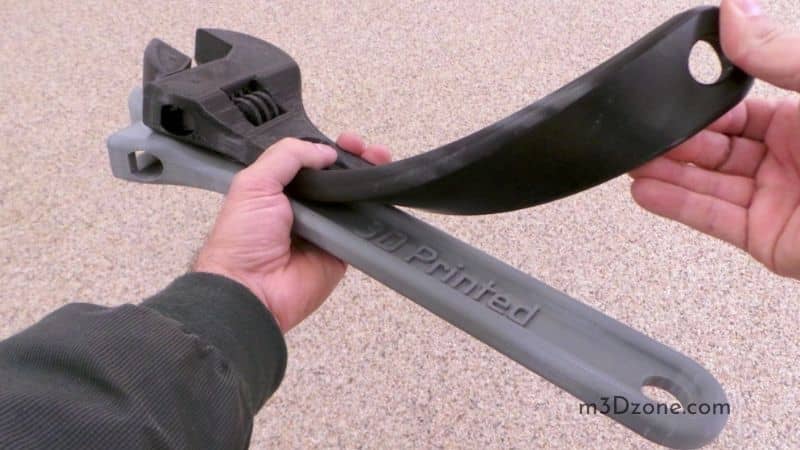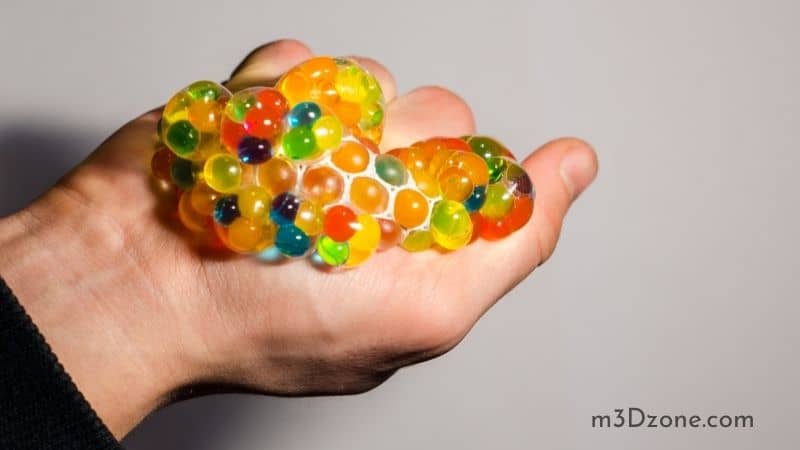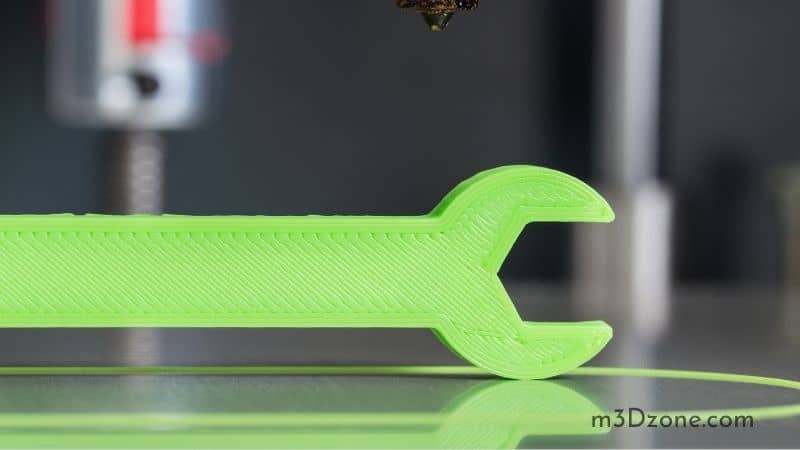TPU is one of the most popular flexible 3D printing filaments on the market.

As an Amazon Associate, I earn from qualifying purchases. If you make a purchase after clicking on a link I may earn a small commission at no extra cost to you.
Thermoplastic Polyurethane, or TPU, originates from a class of polyurethane plastics with important features such as high elasticity, transparency, and resistance to abrasion, oil, and grease.
Quick Navigation
- What is TPU Filament?
- What Is TPU Flexible Filament Used For?
- How Flexible Is TPU Filament?
- Can You Use Thermoplastic Polyurethane (TPU) for 3D Printing?
- What Is the Difference Between TPU and PLA?
- How to Store TPU Filament?
- How to Smooth TPU 3D Filament Flexible Materials?
- Is TPU Filament Toxic?
- Is TPU Filament Food Safe?
- Conclusion
It stands out from other filament materials due to its extremely flexible nature. TPUs are made up of thermoplastic elastomers, but it is better to separate them from acids, solvents, and fuels as they can affect the filament materials’ properties.
What is TPU Filament?
Thermoplastic polyurethane (TPU) is a common form of elastic polymer or elastomer used on any properly equipped 3D printer.
Compared to the many kinds of flexible 3D filaments, TPU filament is more rigid, making it easier to extrude and use. It’s a medium strength filament material with very high durability and flexibility and can stand much higher compressive and tensile forces than its common equivalents PLA and ABS.
TPU filaments are available in different types depending on their application:
- Polyester TPU filaments – derived from adipic acid esters
- Polyether TPU filaments – derived from tetrahydrofuran ethers
- Polycaprolactone TPU filaments – derived from thermoplastic Polyurethane elastomer.
Polyester-based TPU filaments are commonly used for resisting oil and hydrocarbons, while polyether TPU filaments are used in wet environments. Polycaprolactone-based filaments usually perform optimally at low temperatures and are more resistant to hydrolysis.
TPUs exclusive features such as abrasion resistance make it a great option for a wide variety of applications, especially in automotive instrument panels.
Compared to the TPE filament (check at Amazon), TPU flexible filaments are easier to print and retain the elastic features better at low temperatures.
A TPU filament material is more flexible and has better conformity than other thermoplastic forms.
The filament has a great interlayer adhesion and does not delaminate or curl during the printing process when you use the right 3D printer settings.
What Is TPU Flexible Filament Used For?
TPU filament is commonly used in medical devices, drive belts, inflatable rafts, caster wheels, automotive industry panels, power tools, sporting equipment, footwear, and some extruded film and sheet applications.
TPU filament material is great for making custom outer cases for mobile devices such as phones and tablets, rubber mats, and stress toys. It can also be used for tires or shock absorbers occasionally in the manufacture of O-rings and seals.

The TPU filament is perfect for flexible parts or casings and parts that need resistance to sudden impacts and movement when it comes to DIY.
How Flexible Is TPU Filament?
The flexibility of TPU is excellent. The temperature at which TPU filament is likely to extrude is between 220-250 degrees.
If you use a heated build platform, ensure that its temperature is not higher than 60 degrees. The extruder system will need to withstand flexible and compressible materials up to a constant temperature of 250 degrees.
3D printing settings also affect the flexibility of the 3D filament. When you use a low level to infill, the printed design will also be more flexible.
This creates room for printing objects that are more rigid and elastic.
In 3D printing, flexible TPU filaments require the transfer of larger amounts of energy than the other filament materials.
Can You Use Thermoplastic Polyurethane (TPU) for 3D Printing?
Absolutely. TPU 3D printing offers unique features unachievable with other printing materials like PLA, ABS, or nylon.

Combining the properties of plastic and rubber, TPU filament can produce durable, highly elastic parts that can easily be compressed.
It is important to understand the upsides and downsides when it comes to 3D printing with TPU filament. You should also consider the possible issues before starting 3D printing with TPU material to know what to expect.
Here are a few tips for 3D printing with TPU filament material for amazing TPU prints:
-
Optimizing the feed rate
You are recommended to use a consistent feed rate and slow feed rate when 3D printing with flexible filaments. This is because the printing material is elastic and can be uncontrollable in case of sudden changes to the print speed.
Increased printing speeds can cause compression of the filament resulting in a jam. It usually takes several attempts to set the optimal print speed for 3D printing TPU filament material.
However, a good printing speed to start with is 35mm/s.
To obtain this using TPU filament material, print lower layer heights while making sure they range between 0.1mm and 0.2mm. A lower layer height calls for less plastic, which means that the extruder feeds at a lower rate, which eases the filament material burden.
-
Use a negative tolerance and avoid using rafts
You should use a negative tolerance between a flexible part and a requirement to fit on top of another object. This will ensure that the flexible part has the allowance to stretch comfortably over the other object.
When using flexible filament material such as TPU, it is vital to avoid using rafts since base layers have a higher extrusion rate which could cause problems.
-
Optimize the retraction settings
The flexibility and elasticity feature makes the TPU filament material sensitive to fast movements such as retractions.
Therefore, to successfully 3D print with flexible TPU filaments, you need to optimize the retraction settings to limit movements. Start with a small amount of retraction with a slower print speed to help eliminate any oozing from the extruder.
-
Shorten the distance
Shortening the distance is a general opinion in favor of 3D printing flexible materials with a Direct Drive extruder. Nonetheless, you can obtain similar results when using the right settings on a 3D printer with a Bowden extruder.
It is important to ensure tight tolerances for the path in which the filament travels to prevent kinking or coiling.
-
Placement of the spool
A few tweaks to the spool of the flexible material can make a significant difference. Usually, the extruder drive pulls the printer filament into the nozzle, which causes the filament spool to unwind a small amount of plastic in the printing process.
However, as a TPU material is more elastic, the filament is stretched while pulled, and this can result in under extrusion. For this reason, mount the spool above the 3D printer so that the filament unwinds downwards to reduce any resistance.
What Is the Difference Between TPU and PLA?
PLA is easier to print with, more environmentally friendly, and is compostable than TPU. TPU material is suitable for flexible parts that can return to their original state after bending.
So, if you want the easiest filament for 3D printing, you have to use PLA (check at Amazon), but if you are looking to add flexibility to your prints, you can use TPU.
How to Store TPU Filament?
Flexible TPU filament can be stored in a cool, airtight container, like PolyBox (check at Amazon). The storage container may also have a desiccant pack to keep the filament bone dry.
The airtight container also helps prevent the entry of dirt and dust particles so that you can use the filament anytime to print.
Although some TPU filaments are water-resistant, exposing the TPU to water can cause degradation of the product.
How to Smooth TPU 3D Filament Flexible Materials?
One of the most effective ways to smooth print lines without using expensive equipment is to use epoxy resin (check at Amazon).
Filler primer, the material used to fill in print lines in PLA prints, is unfortunately poorly suited to fill TPU lines as the flexible nature of the material causes the primer to crack and chip or flake off if it’s not adhering properly.
However, the only filler primers that can be made more flexible are automotive 2k primers with a mixed flex compound which requires an expensive compressor and HVLP sprayer (check at Amazon) set up.
When it comes to 3D printing, shore hardness is the extent to which a printing material resists indentation.
Shore A measures the objects of medium softness. For instance, a rubber band will have a Shore A hardness of 20, while a denser and harder rubber-like wheel on a shopping trolley can have a Shore A hardness of 90.
A different shore hardness metric is used to measure the hardness of more rigid materials; the Shore D. A car tire would have a Shore D hardness of around 20 an object very rigid and hard like a building and construction helmet could have a hardness of 80 D.
TPU flexible filaments have shore hardness between 75 D and 98 A.
Is TPU Filament Toxic?
TPU filament materials are not toxic and are considered safe for many applications depending on several considerations. TPU filament is even used in biomedical applications. It is a versatile compound with a great abrasion resistance that is commonly used in our daily lives.
Is TPU Filament Food Safe?
TPU filament material doesn’t emit any exceptional levels of fumes while 3D printing, but it’s not considered food safe.
Although TPU is a non-soluble material, it is hygroscopic, which means it will absorb moisture from its environment, degrading over time.
Conclusion
TPU filament is a medium-strength 3D printing material that withstands high compressive, tensile forces than its counterparts PLA and ABS.
TPU flexible filaments have exceptional qualities that make it your ultimate choice for a 3D printing project that needs elastic material thanks to its rubber-like features.
If you are looking for a flexible filament, you’re in luck, as TPU filament is the go-to material that is easier to manage than its common counterparts.
Recommended Reading
How Much Does It Cost to Run a 3D Printer (At Home)?
How much does it cost to run a 3D printer it's a question that many users ask. The overall cost of running a 3D printer depends on so many factors. Let's see!
What Is FDM 3D Printing?
Fused Deposition Modeling(FDM) and Fused Filament fabrications (FFF) are the same. The FDM or FFF uses additive manufacturing 3D printing technology.
What Is a Resin 3D Printer?
So, what is a 3D resin printer? A resin 3D printer is a machine that uses light to convert models to prints. By directing UV light onto resins ...
